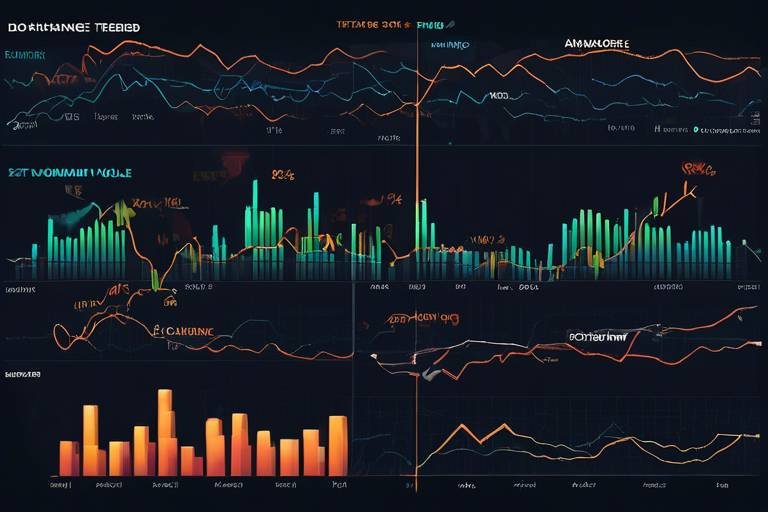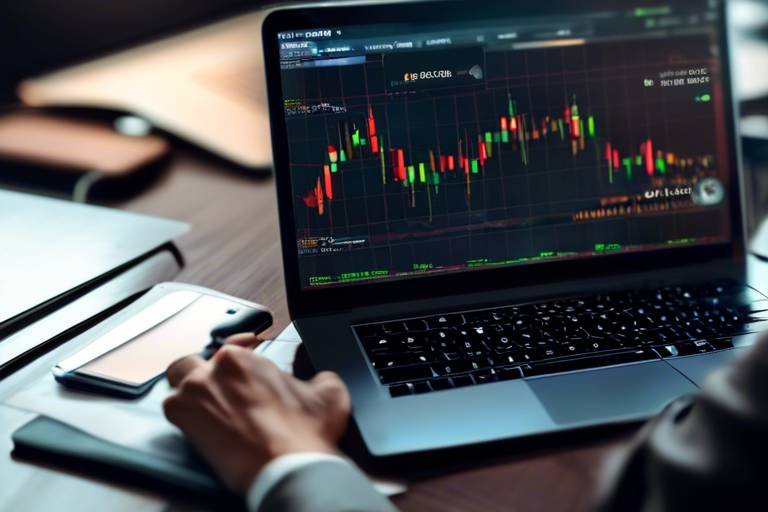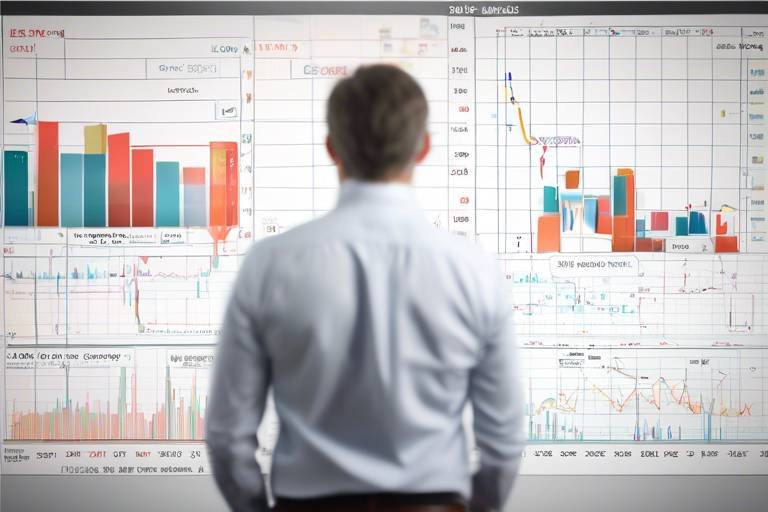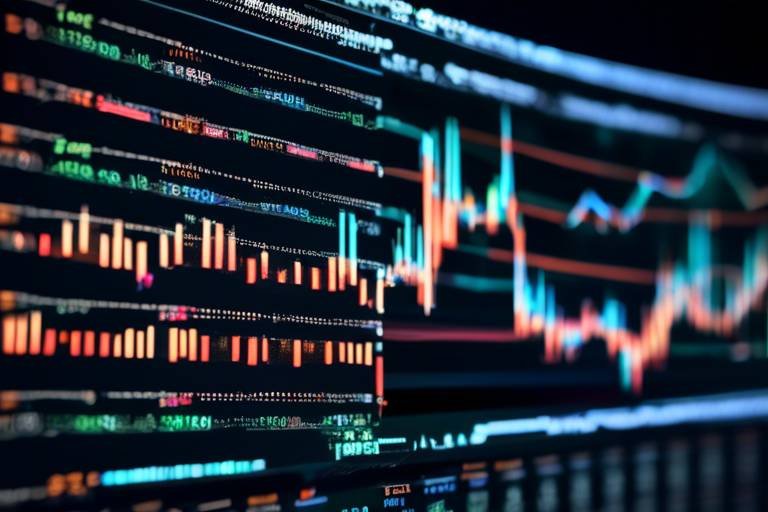How to Analyze Exchange Volume Trends
This article explores the importance of analyzing exchange volume trends in financial markets, offering insights into market behavior, investor sentiment, and trading strategies to enhance decision-making for traders and investors alike.
Exchange volume represents the total number of shares or contracts traded within a specific period. Analyzing this metric helps investors gauge market activity and liquidity, providing a clearer picture of market dynamics. Think of it as the heartbeat of the market; the stronger the heartbeat, the more vibrant the market activity. When you see a surge in volume, it's like a loud cheer from the crowd, signaling that something significant is happening.
Volume analysis is crucial for understanding price movements and identifying potential reversals. It allows traders to confirm trends and make informed decisions based on the strength of market participation. Imagine trying to navigate a ship through the fog; volume acts as your lighthouse, guiding you through uncertain waters. It’s not just about price; it’s about knowing how many people are joining the party and how excited they are!
The relationship between volume and price is a key indicator of market strength. High volume accompanying price increases suggests strong buying interest, while low volume may indicate weakness or uncertainty. In simpler terms, if the price is climbing and the volume is robust, it’s like a roaring engine propelling you forward. Conversely, if the price is rising but the volume is low, it could feel like you're pushing a car uphill without enough gas—something's not quite right!
Recognizing trends through volume can help traders anticipate future price movements. Increased volume during an uptrend signals confidence, while declining volume may indicate a potential trend reversal. Picture yourself at a concert; when the crowd is jumping and cheering, you know the band is hitting all the right notes. But if the crowd starts to dwindle, it might be time to reconsider your next move.
Volume spikes often precede significant market events. Identifying these spikes can help traders capitalize on sudden price movements, making them a vital aspect of volume analysis. Think of volume spikes as fireworks in the night sky—unexpected and eye-catching! They can signal that something big is about to happen, whether it's a breakout or a breakdown.
Several volume indicators, such as On-Balance Volume (OBV) and the Volume Price Trend (VPT), assist traders in analyzing trends. These tools provide insights into the strength of price movements and potential market reversals. For example, OBV adds volume on up days and subtracts it on down days, creating a cumulative line that can help traders visualize market momentum. It’s like a scoreboard that tells you who’s winning the game!
Recognizing volume patterns is essential for effective trading strategies. Patterns such as accumulation and distribution can indicate whether a security is being accumulated or sold off by investors. When you see accumulation, it’s like a gathering of friends before a party—everyone’s excited and ready to join in. On the other hand, distribution feels like the party’s winding down, with people starting to leave.
Understanding accumulation and distribution phases helps traders determine market sentiment. Accumulation occurs when buying interest outweighs selling, while distribution indicates a shift towards selling pressure. This dynamic is crucial; it’s the difference between a stock ready to soar and one that’s about to take a nosedive.
Volume confirmation is crucial for validating price movements. Traders often seek volume spikes to confirm breakouts or breakdowns, ensuring that price changes are supported by significant market activity. It’s like checking the weather before heading out; you want to ensure it’s not just a fluke before making your move.
Volume analysis can be applied in various trading strategies, including day trading and swing trading. Understanding how to leverage volume can enhance trading outcomes and risk management. By incorporating volume analysis into your trading strategy, you can make decisions that are not only informed but also timely, potentially increasing your chances of success.
- What is exchange volume?
Exchange volume refers to the total number of shares or contracts traded within a specific period, indicating market activity.
- Why is volume analysis important?
Volume analysis helps traders understand market sentiment, confirm trends, and make informed trading decisions.
- What are volume indicators?
Volume indicators, such as On-Balance Volume (OBV) and Volume Price Trend (VPT), help traders analyze the strength of price movements.
- How can I use volume in my trading strategy?
Incorporate volume analysis to confirm trends, identify potential reversals, and enhance your overall trading strategy.

Understanding Exchange Volume
Exchange volume is a fundamental concept in the world of financial markets, representing the total number of shares or contracts traded within a specific period. Think of it as the heartbeat of the market; the stronger the heartbeat, the more active the market is. Analyzing this metric is essential for investors and traders alike, as it helps gauge market activity and liquidity, providing a clearer picture of market dynamics. When you see high exchange volume, it can indicate that a security is in demand, while low volume might suggest a lack of interest or uncertainty among investors.
To put it simply, exchange volume gives you a snapshot of how many people are buying and selling at any given moment. If you think about it, if a stock has a high volume, it’s like a crowded marketplace buzzing with activity, while low volume resembles a quiet, deserted street. This comparison highlights how volume can impact the perception of a stock's value and potential price movements.
Moreover, understanding exchange volume is crucial for making informed trading decisions. For instance, if you notice a sudden spike in volume, it could be a signal that something significant is happening with that security. This could be due to news, earnings reports, or other market-moving events. Therefore, keeping an eye on volume trends can not only enhance your understanding of market behavior but also improve your timing when entering or exiting trades.
Here’s a quick breakdown of why exchange volume matters:
- Liquidity: High volume typically indicates better liquidity, meaning you can buy or sell without drastically affecting the price.
- Market Sentiment: Volume can reflect investor sentiment; rising volume during price increases suggests bullish sentiment, while increasing volume during price declines indicates bearish sentiment.
- Trend Confirmation: Analyzing volume helps confirm the strength of a price trend. A price move accompanied by high volume is more likely to be sustainable.
In summary, understanding exchange volume is not just about crunching numbers; it's about interpreting the story behind those numbers. It’s like being a detective, piecing together clues to understand market movements and investor behavior. By mastering this skill, you can enhance your trading strategies and make more informed decisions in the fast-paced world of finance.

Importance of Volume Analysis
When it comes to trading in financial markets, understanding the cannot be overstated. Volume analysis serves as a cornerstone for traders and investors alike, providing them with critical insights into market behavior and investor sentiment. Think of volume as the heartbeat of the market; it tells you how active the market is and whether there’s a strong pulse behind price movements. Without analyzing volume, you might be navigating through the market blindfolded.
One of the most compelling reasons to analyze volume is its ability to confirm price movements. Imagine you’re watching a stock that’s climbing steadily. If this price increase is accompanied by high volume, it’s a strong indication that there’s genuine interest from investors, suggesting that the trend is likely to continue. On the flip side, if a price increase occurs on low volume, it raises a red flag. It could mean that the rally is weak and might not last. This relationship between volume and price is essential for traders looking to make informed decisions.
Moreover, volume analysis plays a crucial role in identifying potential reversals in the market. For instance, if a stock has been on a downtrend but suddenly experiences a spike in volume as it approaches a support level, it could indicate that buyers are stepping in, signaling a potential reversal. Conversely, if a stock is in an uptrend and volume begins to dwindle, this might suggest that sellers are starting to take control, which could lead to a price drop. Understanding these dynamics can significantly enhance your trading strategies.
In addition, volume analysis helps in recognizing trends and their strength. When you see increased volume during an uptrend, it reflects confidence among traders. Conversely, if the volume starts to decline, it may indicate a lack of interest, which could foreshadow a trend reversal. This is akin to watching a sports game; if you notice the crowd getting quieter, it might be a sign that the team is losing momentum.
Finally, volume analysis can also aid in risk management. By understanding volume trends, traders can set more informed stop-loss levels and position sizes. For example, if a trader identifies that a stock is experiencing high volume at a certain price level, they might decide to place a stop-loss just below that level, as the increased volume suggests that it’s a significant area of interest for buyers.
In summary, volume analysis is not just a technical tool; it’s an essential part of a trader's toolkit that aids in making informed decisions, confirming trends, and managing risks effectively. By incorporating volume analysis into your trading strategy, you can gain a clearer understanding of market dynamics and enhance your overall trading performance.
- What is exchange volume? Exchange volume refers to the total number of shares or contracts traded within a specific period.
- Why is volume analysis important? Volume analysis helps confirm price movements, identify potential reversals, and understand market sentiment.
- How can I use volume analysis in my trading? You can use volume analysis to confirm trends, set stop-loss levels, and make more informed trading decisions.
- What are some common volume indicators? Common volume indicators include On-Balance Volume (OBV) and the Volume Price Trend (VPT).

Volume and Price Relationship
The relationship between volume and price is one of the most critical aspects of market analysis. Understanding how these two elements interact can provide traders with invaluable insights into market strength and potential future movements. Think of volume as the fuel that drives the price of a security. When there's a surge in volume, it often indicates that something significant is happening, and this can lead to notable price changes.
To illustrate this relationship, consider the following scenarios:
- High Volume with Price Increase: This combination typically signals strong buying interest. When many investors are purchasing a security, it reflects confidence in its future performance. For example, if a stock's price rises from $50 to $60 with a significant increase in trading volume, it suggests that buyers are eager to own that stock, reinforcing the upward trend.
- High Volume with Price Decrease: Conversely, when a security's price drops significantly on high volume, it often indicates strong selling pressure. This scenario can suggest that investors are losing faith in the asset, leading to further declines. If a stock falls from $60 to $50 with heavy trading activity, it may signal that sellers are dominating the market.
- Low Volume with Price Increase: When prices rise but volume remains low, it can be a warning sign. This situation may imply that the upward movement lacks strong support, indicating potential weakness in the trend. Traders should be cautious, as this could lead to a reversal.
- Low Volume with Price Decrease: A price drop on low volume often suggests a lack of conviction among sellers. It can indicate that the market is not fully engaged, and the price movement may not be sustainable.
In essence, analyzing the interplay between volume and price can help traders validate their strategies and make more informed decisions. It's essential to look for patterns and trends that emerge from this relationship. For instance, if a stock is consistently rising in price while maintaining high volume, it may indicate a strong bullish trend. On the flip side, if the price is falling with increasing volume, it often signals a bearish sentiment.
Moreover, traders often use technical indicators to quantify this relationship. Tools like the On-Balance Volume (OBV) and the Accumulation/Distribution Line help visualize how volume affects price movements over time. These indicators can be crucial in confirming whether a trend is likely to continue or reverse.
Ultimately, understanding the volume-price relationship is not just about recognizing patterns—it's about interpreting the underlying sentiment of the market. By staying attuned to these dynamics, traders can better position themselves to capitalize on opportunities and mitigate risks.
Q: Why is volume important in trading?
A: Volume is crucial because it indicates the strength of price movements. High volume can confirm trends, while low volume may suggest weakness.
Q: How can I use volume to identify market trends?
A: By observing volume changes alongside price movements, traders can identify potential trends. Increased volume during a price rise usually indicates a strong trend, while decreasing volume may signal a reversal.
Q: What are some common volume indicators?
A: Some popular volume indicators include On-Balance Volume (OBV), Volume Price Trend (VPT), and the Accumulation/Distribution Line. These tools help traders analyze the relationship between volume and price movements.
Q: Can low volume be a signal for trading?
A: Yes, low volume can indicate a lack of conviction in price movements. It can serve as a warning sign for traders to be cautious about entering positions.

Identifying Trends
Identifying trends in exchange volume is like being a detective in the bustling world of financial markets. You have to look for clues, patterns, and signals that can guide your trading decisions. When you see increased volume during an uptrend, it's akin to a crowd cheering for their favorite team; it signifies confidence and enthusiasm among investors. This surge in activity often indicates that many traders are buying into the asset, which can lead to further price increases.
Conversely, if you observe declining volume during a price rise, it might signal a lack of conviction among buyers. Think of it as a party where the guests are slowly leaving; it suggests that the excitement is waning, and a potential trend reversal could be on the horizon. Recognizing these subtle shifts in volume can be the difference between riding a wave of profits and getting caught in a downturn.
To further illustrate the importance of identifying trends through volume, consider the following scenarios:
- Rising Volume on Uptrends: When the price of an asset is increasing and volume is also rising, it indicates strong buying momentum. This is a bullish signal that can encourage traders to enter positions.
- Rising Volume on Downtrends: If the price is falling and volume is increasing, it suggests that sellers are gaining strength. This could be a warning sign for traders holding long positions.
- Declining Volume on Uptrends: A price increase accompanied by decreasing volume may signal that the trend is losing steam, prompting traders to consider taking profits or tightening stop-loss orders.
- Declining Volume on Downtrends: If a stock is falling but volume is decreasing, it might indicate that sellers are losing interest, potentially setting the stage for a reversal.
By closely monitoring these trends, traders can make informed decisions that align with market dynamics. It’s essential to combine volume analysis with other technical indicators to create a comprehensive trading strategy. For instance, pairing volume trends with moving averages or momentum indicators can provide a clearer picture of market sentiment and potential price movements.
In conclusion, identifying trends in exchange volume is not just about numbers; it’s about understanding the psychology of the market. By paying attention to how volume behaves in relation to price movements, traders can gain valuable insights that enhance their decision-making process. This analytical approach can empower investors to navigate the complexities of the financial markets with confidence and precision.
- What is exchange volume? Exchange volume refers to the total number of shares or contracts traded within a specific period, indicating market activity and liquidity.
- Why is volume analysis important? Volume analysis helps traders understand price movements, confirm trends, and identify potential reversals based on market participation.
- How can I identify trends using volume? Look for patterns such as rising volume during uptrends or downtrends, and be aware of declining volume as potential signals for trend reversals.
- What are some common volume indicators? Common volume indicators include On-Balance Volume (OBV) and the Volume Price Trend (VPT), which help analyze the strength of price movements.

Volume Spikes
When it comes to trading, are like the fireworks of the financial markets—sudden, bright, and impossible to ignore! These spikes represent a significant surge in trading activity, often signaling that something important is happening. Whether it’s a major news announcement, earnings report, or other impactful events, volume spikes can provide traders with critical insights into market behavior.
Imagine you’re at a concert, and the crowd suddenly erupts in cheers. That surge of energy reflects the excitement in the air, just like a volume spike indicates heightened market enthusiasm. When you see a spike in volume, it’s essential to dig deeper to understand what’s driving that activity. Is it genuine buying interest, or are traders simply reacting to rumors? The context behind the spike can often determine your next move.
One of the primary reasons volume spikes are so valuable is that they can serve as early indicators of price movements. For instance, if you notice a sudden increase in volume while the price is rising, it suggests that buyers are stepping in, which can lead to further price increases. Conversely, if a volume spike occurs during a price drop, it may indicate panic selling, which could foreshadow a more significant decline.
To help illustrate the impact of volume spikes, consider the following table that outlines recent market events and their corresponding volume spikes:
| Event | Date | Volume Change (%) | Price Movement (%) |
|---|---|---|---|
| Earnings Report Release | 2023-10-01 | 150% | +10% |
| Market News Announcement | 2023-10-10 | 200% | -5% |
| Product Launch | 2023-10-15 | 180% | +15% |
As you can see, significant events often correlate with dramatic increases in trading volume. This relationship emphasizes the importance of monitoring volume spikes as part of your trading strategy. By staying alert to these spikes, traders can position themselves to capitalize on potential market movements, whether that means entering a trade or adjusting existing positions.
In conclusion, volume spikes are not just random occurrences; they are vital signals that can guide your trading decisions. By understanding the context and implications of these spikes, you can enhance your market analysis and improve your overall trading strategy. So, the next time you see a volume spike, don’t just glance at it—take a moment to investigate and see what opportunities it might present!
- What causes volume spikes? Volume spikes can be triggered by various factors, including news releases, earnings reports, or significant market events that capture traders' attention.
- How can I identify volume spikes? Traders often look for sudden increases in volume compared to the average volume over a specific period to identify spikes.
- Are volume spikes always a good sign? Not necessarily. While they can indicate strong market interest, it's crucial to analyze the context behind the spike to determine its significance.
- Can volume spikes predict price movements? Yes, volume spikes can serve as indicators of potential price movements, but they should be used in conjunction with other analysis tools for better accuracy.

Volume Indicators
When it comes to trading, volume indicators are your trusty sidekicks, helping you navigate the sometimes murky waters of market trends. These indicators provide valuable insights into the strength of price movements, allowing traders to make informed decisions. One of the most popular volume indicators is the On-Balance Volume (OBV). This tool aggregates volume data and assigns a positive value when the price closes higher and a negative value when it closes lower. The idea is simple: if the OBV is rising, it suggests that buyers are in control, while a declining OBV indicates increased selling pressure.
Another essential indicator is the Volume Price Trend (VPT). This combines price movements and volume to provide a clearer picture of market sentiment. The VPT increases when the price rises and volume is high, suggesting strong buying interest, while it decreases when the price falls with high volume, indicating selling pressure. Traders often use these indicators in conjunction to confirm trends and make strategic decisions.
But wait, there’s more! Let’s not forget about the Average Volume. This indicator calculates the average number of shares traded over a specific period, helping traders identify significant changes in trading activity. For instance, if the current volume is significantly higher than the average, it could signal a potential breakout or breakdown, prompting traders to take action.
To illustrate how these indicators work together, consider the following table:
| Indicator | Purpose | How to Use |
|---|---|---|
| On-Balance Volume (OBV) | Measures buying and selling pressure | Look for divergences between OBV and price trends |
| Volume Price Trend (VPT) | Combines volume and price to indicate market sentiment | Use to confirm price movements with volume |
| Average Volume | Identifies significant changes in trading activity | Watch for current volume exceeding the average |
In conclusion, mastering volume indicators is like having a secret weapon in your trading arsenal. By understanding how these tools function, you can enhance your ability to predict market movements and make more informed trading decisions. So next time you’re analyzing a stock or cryptocurrency, don’t overlook the power of volume indicators!
- What is the significance of volume in trading? Volume is a crucial metric that indicates the strength of a price movement. High volume can confirm trends, while low volume may suggest weakness.
- How can I use volume indicators effectively? Use volume indicators in conjunction with price action to confirm trends and identify potential reversals. Look for divergences and significant changes in volume compared to averages.
- Are volume indicators suitable for all trading strategies? Yes, volume indicators can be applied across various trading strategies, including day trading, swing trading, and long-term investing.

Interpreting Volume Patterns
Recognizing volume patterns is essential for effective trading strategies. Just like reading the mood of a crowd at a concert, understanding how volume behaves can give traders crucial insights into market sentiment. When you see certain patterns emerge, it’s like spotting a trend in a sea of noise. You can often decipher whether investors are feeling bullish or bearish about a security. For instance, when volume increases alongside rising prices, it often indicates that there’s a strong buying interest. Conversely, if prices are rising but volume is low, it might be a sign of weakness, like a cheer that doesn’t quite resonate with the audience.
One of the key volume patterns traders look for is the difference between accumulation and distribution. Accumulation occurs when buying interest outweighs selling, suggesting that investors are confident in the asset's future. This phase is characterized by increasing volume as prices stabilize or gradually rise, indicating that savvy investors are loading up on shares before the price takes off. On the other hand, distribution happens when selling pressure starts to outweigh buying interest. This can lead to a decline in prices, and volume often spikes as investors rush to offload their positions. Recognizing these patterns can be the difference between riding the wave of a bull market or getting caught in a bear trap.
Another vital aspect of interpreting volume patterns is looking for volume confirmation. This is crucial for validating price movements. Traders often seek volume spikes to confirm breakouts or breakdowns. For example, if a stock breaks through a resistance level but does so on low volume, it might not be a sustainable move. However, if that same breakout is accompanied by a significant increase in volume, it signals that the price change is supported by strong market activity, much like a standing ovation that confirms the performance was indeed a hit.
To illustrate how volume patterns can impact trading decisions, consider the following table that summarizes key volume patterns and their implications:
| Volume Pattern | Implication |
|---|---|
| High Volume with Rising Prices | Strong buying interest; potential continuation of the uptrend. |
| High Volume with Falling Prices | Strong selling pressure; potential continuation of the downtrend. |
| Low Volume with Rising Prices | Weak buying interest; possible reversal or price correction. |
| Volume Spike | Indicates significant market event; potential for sharp price movement. |
In conclusion, interpreting volume patterns is not just about numbers; it’s about understanding the story they tell. By paying attention to these patterns, traders can make more informed decisions and enhance their trading strategies. So, the next time you’re analyzing a stock, take a moment to observe the volume patterns and let them guide your trading journey.
- What is volume analysis? Volume analysis involves examining the number of shares or contracts traded during a specific period to gauge market activity and liquidity.
- Why is volume important in trading? Volume is crucial because it helps confirm trends, indicating whether price movements are supported by significant market activity.
- How can I identify accumulation and distribution phases? Accumulation occurs when buying interest exceeds selling, while distribution happens when selling pressure increases, often marked by corresponding volume changes.
- What are volume indicators? Volume indicators, like On-Balance Volume (OBV) and Volume Price Trend (VPT), help traders analyze trends and assess market strength.

Accumulation vs. Distribution
When diving into the world of trading, understanding the concepts of accumulation and distribution is like having a compass in a dense forest. These two phases are critical for interpreting market sentiment and can significantly influence your trading decisions. So, what exactly do these terms mean?
Accumulation occurs when investors are actively buying a security, leading to a gradual increase in its price. Think of it as a group of people gathering around a popular food truck; the more people that join, the more enticing the food truck seems. In this phase, buying pressure outweighs selling pressure, indicating a bullish sentiment. Traders often look for signs of accumulation, such as increased volume during price consolidation, as it suggests that savvy investors are positioning themselves for future gains.
On the flip side, we have distribution. This is when the smart money starts to sell off their holdings, often after a significant price increase. Imagine a party where the music is getting louder, and people are starting to leave; that’s distribution. Here, selling pressure surpasses buying pressure, signaling a potential bearish phase. Recognizing distribution can help traders avoid getting caught in a downward spiral, allowing them to exit positions before losses mount.
To further illustrate the differences between these two phases, let’s take a look at the following table:
| Aspect | Accumulation | Distribution |
|---|---|---|
| Market Sentiment | Bullish | Bearish |
| Volume Trend | Increasing | Decreasing |
| Price Movement | Gradual Increase | Gradual Decrease |
| Investor Behavior | Buying | Selling |
Recognizing whether a security is in an accumulation or distribution phase can be incredibly beneficial for traders. For instance, if you notice that a stock is experiencing accumulation, it might be a good time to consider entering a position. Conversely, if you see signs of distribution, it may be wise to reevaluate your holdings and consider taking profits or cutting losses.
In conclusion, understanding accumulation and distribution is essential for any trader looking to navigate the complex waters of the financial markets. By paying close attention to these phases, you can enhance your ability to make informed decisions, ultimately leading to better trading outcomes.
- What is the main difference between accumulation and distribution?
Accumulation refers to the phase where buying pressure exceeds selling pressure, while distribution is when selling pressure surpasses buying pressure. - How can I identify accumulation in a stock?
Look for increased trading volume and price stabilization or gradual increases over time. - What indicators can help in analyzing accumulation and distribution?
Volume indicators, such as On-Balance Volume (OBV) and the Volume Price Trend (VPT), can provide insights into these phases.

Volume Confirmation
is a critical aspect of trading that helps validate price movements in the market. When traders observe a price breakout or breakdown, they often look for accompanying volume spikes to confirm the strength of that movement. Think of volume as the fuel that drives the price action; without sufficient fuel, the price movement may not be sustainable. For instance, if a stock breaks above a resistance level but does so with low volume, it raises a red flag. Is the breakout genuine, or is it simply a false alarm?
To illustrate this concept, consider the following example: imagine you’re at a concert. The crowd’s energy—represented by volume—can dramatically affect the atmosphere. If everyone is cheering and singing along (high volume), the concert feels electric, and the band plays with more enthusiasm. Conversely, if only a few people are clapping (low volume), the vibe is lackluster, and the performance might falter. Similarly, in trading, a price movement backed by high volume indicates strong interest and conviction among traders, suggesting that the movement is likely to continue.
Here are some key points to keep in mind regarding volume confirmation:
- Breakouts: A breakout above a resistance level should ideally be accompanied by a surge in volume. This confirms that buyers are stepping in, pushing the price higher.
- Breakdowns: Conversely, a breakdown below a support level with high volume signals that sellers are gaining control, which could lead to further declines.
- Volume Divergence: If the price is moving in one direction but volume is decreasing, this divergence can indicate a potential reversal. Traders should be cautious in such scenarios.
Moreover, traders may utilize various volume indicators to enhance their analysis. For example, the On-Balance Volume (OBV) indicator accumulates volume based on price movements, providing a cumulative view of buying and selling pressure. If the OBV is rising while the price is stagnant, it indicates that the price may soon catch up with the volume, leading to a potential breakout.
In summary, volume confirmation is essential for making informed trading decisions. By paying attention to volume spikes and understanding their implications, traders can better navigate the complexities of the market. Remember, just as a well-timed cheer can elevate a concert, the right volume at the right time can significantly impact your trading success.
- What is volume confirmation? Volume confirmation refers to the use of volume analysis to validate price movements, ensuring that significant price changes are supported by strong market activity.
- Why is volume important in trading? Volume is important because it provides insights into market activity and investor sentiment, helping traders make informed decisions about potential price movements.
- How can I identify volume spikes? Volume spikes can be identified by monitoring trading volume charts and looking for sudden increases in volume that coincide with price movements.
- What volume indicators should I use? Popular volume indicators include On-Balance Volume (OBV), Volume Price Trend (VPT), and Accumulation/Distribution Line, each providing different insights into market dynamics.

Practical Applications of Volume Analysis
When it comes to trading, understanding the can significantly enhance your strategy and decision-making process. Volume analysis is not just a theoretical concept; it has real-world implications that can help traders navigate the often turbulent waters of financial markets. By incorporating volume analysis into your trading toolkit, you can gain a competitive edge, whether you are a day trader looking for quick profits or a swing trader aiming for longer-term gains.
One of the most effective ways to leverage volume analysis is through day trading. Day traders thrive on short-term price movements, and volume can provide critical insights into these fleeting opportunities. For instance, when a stock experiences a sudden spike in volume, it often signals a potential breakout or breakdown. This surge can indicate that something significant is happening, whether it’s news affecting the stock or a broader market trend. By acting quickly during these volume spikes, day traders can capitalize on rapid price movements, maximizing their profits.
Similarly, in swing trading, volume analysis plays a pivotal role. Swing traders typically hold positions for several days or weeks, aiming to profit from short- to medium-term price shifts. By analyzing volume trends, swing traders can identify whether a stock is in an accumulation or distribution phase. For instance, if a stock is steadily increasing in price with rising volume, it suggests strong buying interest and may indicate a good opportunity to enter a position. Conversely, if the price is climbing but volume is declining, it could signal potential weakness, urging traders to reconsider their strategy.
Here’s a quick overview of how volume analysis can be applied in different trading strategies:
| Trading Strategy | Application of Volume Analysis |
|---|---|
| Day Trading | Identifying volume spikes to capitalize on short-term price movements. |
| Swing Trading | Using volume trends to determine accumulation or distribution phases. |
| Position Trading | Monitoring long-term volume trends to assess overall market health. |
Moreover, volume analysis can also aid in risk management. By understanding volume patterns, traders can set more informed stop-loss orders. For example, if a stock has a history of high volume during downturns, traders might choose to set tighter stop-loss levels to protect their capital. This proactive approach can help mitigate losses during unexpected market fluctuations.
In summary, integrating volume analysis into your trading strategy can enhance your ability to make informed decisions. Whether you are day trading, swing trading, or investing for the long term, recognizing the implications of volume can provide valuable insights into market behavior. So, the next time you analyze a stock, take a moment to consider its volume trends; they might just reveal the hidden opportunities you’ve been searching for!
- What is exchange volume? Exchange volume refers to the total number of shares or contracts traded within a specific timeframe, reflecting market activity and liquidity.
- How can I use volume analysis in my trading? You can use volume analysis to identify trends, confirm price movements, and set risk management strategies, enhancing your overall trading performance.
- What are some volume indicators I should know about? Some popular volume indicators include On-Balance Volume (OBV) and Volume Price Trend (VPT), which help assess market strength and potential reversals.
Frequently Asked Questions
- What is exchange volume and why is it important?
Exchange volume refers to the total number of shares or contracts traded during a specific time frame. It's essential because it provides insights into market activity and liquidity, helping investors understand how actively a security is being traded. High volume often indicates strong interest, which can lead to more reliable price movements.
- How can I analyze volume trends effectively?
To analyze volume trends, start by monitoring the volume alongside price movements. Look for patterns such as volume spikes or declines, which can signal potential reversals or continuations. Utilizing volume indicators like On-Balance Volume (OBV) and Volume Price Trend (VPT) can also enhance your analysis by providing deeper insights into market strength.
- What does it mean when volume increases during an uptrend?
An increase in volume during an uptrend typically signals strong buying interest and confidence among investors. This suggests that the price movement is supported by significant market activity, making it more likely to continue in the same direction.
- How do I identify accumulation and distribution phases?
Accumulation occurs when buying interest exceeds selling, often indicated by rising volume as prices stabilize or increase. Conversely, distribution happens when selling pressure outweighs buying, usually seen through declining volume amidst price increases. Recognizing these phases can help you gauge market sentiment and make informed trading decisions.
- What role do volume spikes play in trading?
Volume spikes are critical as they often precede significant market movements. When you spot a volume spike, it can indicate that a breakout or breakdown is imminent, allowing you to position yourself advantageously. Traders often look for these spikes to confirm their trading strategies and validate price changes.
- Can volume analysis be applied to all trading strategies?
Absolutely! Volume analysis is versatile and can be applied across various trading strategies, including day trading and swing trading. By understanding how to leverage volume, traders can enhance their decision-making process, improve risk management, and ultimately achieve better trading outcomes.



















